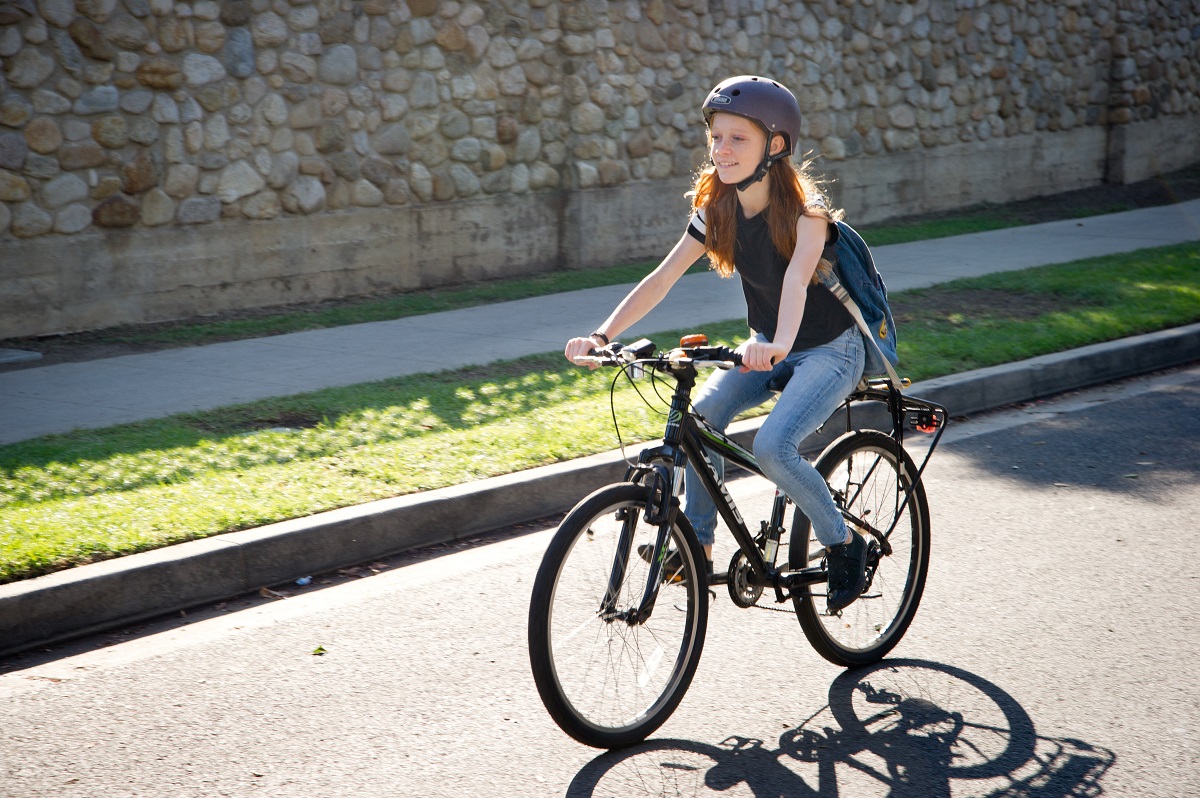
At the Safe Routes Partnership, we’re grateful to be connected to Safe Routes to School programs and staff in communities throughout the country. During these unprecedented times, we’ve heard or seen a number of folks asking about ideas for continuing this important work when schools are closed. How can we still encourage walking and biking safely? How can we support parents looking for ways to keep their kids active at home? How can we ensure that we’re collectively ready to hit the ground running again when schools open back up and we resume our normal daily lives?
Life is very different now than it was a week ago, and for some it is very different today than it was yesterday – and it’s impossible to predict how long it will be until things get back to normal. Two weeks ago we were working with other community advocates advancing safe walking and biking both on the ground and on Capitol Hill. Now many of us are working from home, or continuing to work in our communities in a different capacity than before, likely feeling stressed or uncertain about the future. So, what do we do now?
First, let’s take a collective breath and know that we are all in this together. We need each other more than ever for walking, biking, working, school, community, and everything else in between.
Over the next few weeks we will be crowdsourcing creative ideas, resources, and actions shared by partners or brainstormed by our staff. We hope that these will help you move your work forward or simply feel assured that Safe Routes to School is still here, and will be here when daily life returns to normal. We also believe it’s important for our hardworking partners and staff on the ground to preserve their mental health, so please know that taking a step back and focusing on your health and your family is perfectly normal.
This is the first blog post in a series that will include resources for families to continue being physically active, ideas and resources for Safe Routes to School coordinators to keep up the important work in communities while schools are closed, ideas for how we can support our partners in related areas during this time, and thoughts on how we can make sure kids are walking and rolling when school reconvenes.
News and Inspiration
As we think about our work in supporting communities to establish biking and walking as the norm to school and in everyday life even during the pandemic, we’d like to lead off by elevating the positive stories we’re seeing from around the country as a response to the pandemic.
- In Philadelphia, MLK Drive is closed to motor vehicles to allow more space for (socially distanced) people walking and rolling
- Car-free streets can help pedestrians stay six feet apart to social distance more effectively (FastCompany)
- Philly bikes shops are considered essential businesses
- Bike delivery workers prove their value during the coronavirus crisis
Encourage Physical Activity for Kids – and Adults Too!
Over the years, Safe Routes to School has provided schools and communities with safe, convenient options for students and adults to be physically active during their daily lives by walking or rolling to school. Right now, with schools closed for an unknown length of time in all 50 states, parents may be struggling to keep their kids moving. We partner with a number of organizations working to increase physical education and activity in and out of schools, and many of these partners have released resources for continuing physical education at home. We encourage you to explore and make use of these resources during the Covid-19 crisis and beyond. Here are just a few – please send us any additional resources you come across and we’ll update this list.
- Facebook Live workouts, prerecorded videos, and activity packs for kids at home (BOKS)
- Monday-Friday recess live on Facebook (Playworks)
- Mind and Body Calendars and other resources (Shape America)
- Resources to support the physical, social, and emotional health of children and caregivers (Alliance for a Healthier Generation)
- Fitness Breaks with Pro Athletes (Alliance for a Healthier Generation)
- Special Olympics challenges
Keep Your Safe Routes to School Work Moving from Home
Even if your job typically involves working directly with students in schools, meeting with decision makers, or organizing community events, there is much that can be done to keep building the Safe Routes to School movement. If you have time and want to stay focused on Safe Routes to School, here are some crowdsourced suggestions and resources.
- For schools where distance learning is happening, connect with the school principal and physical education teachers to see how pedestrian and bicycle safety and other curricula you have been using in person can be incorporated.
- Use social media to hold contests or competitions you would have done this spring. Some ideas include holding an online poster contest illustrating “your best ride” or “your best walk” or encouraging families to track their own walks (while social distancing!) and share distances or frequencies accomplished.
- Use the time for planning. How many of us wish we had down time to plan out our programs? Here are things you can do from home:
- Research the schools in your region and gather data about income levels, food access, park locations, crash rates – all information that will come in handy for prioritizing Safe Routes to School work and developing grant applications.
- Review existing curricula (yours or others) and make plans to incorporate them in to school lesson plans next year.
- Watch our past webinars to get ideas for your program.
- Don’t have a Safe Routes to School task force yet? Use down time to research different departments and staff and identify the right advocates for when we return. Check out page 28 of the Building Blocks of Safe Routes to School for tips.
- Review your school’s wellness policy and other policies to see if they can be strengthened for walking/biking to school. See page 31 of the Building Blocks of Safe Routes to School for more guidance.
- Draft messages promoting walking and rolling in advance so you’re ready to go when school resumes. See our guide on Safe Routes to School Messaging for Pros for ideas.
While this list is certainly not exhaustive, we hope it offers some ideas that are quick and easy to use. We will follow up with future blog posts focused on narrower topics. In the meantime, we encourage you to use the Safe Routes to School email discussion group to continue sharing your ideas and tools. We’ve already seen folks sharing great local strategies and resources, and hope the group offers a robust collection of ideas and support for one another during the crisis. Click here to join or email margaux@saferoutespartnership to be added. Here are a few other tips for using the email group:
- When replying to a thread, make sure safe-routes-to-school@googlegroups.com is in the reply field, so the entire group sees the response or resource you’re sharing. If you want to reply to someone directly without copying the entire group, do not include the group address.
- You can attach files to email replies or link to online resources.
- Search past conversations by visiting the email group’s home base online and typing in your query in the “search for messages” bar at the top of the page.
We will continue to share ideas with you in the coming weeks. Our next blog will be focused on advocacy work and what we can all do to keep the momentum going and not lose faith while allying with and supporting partners in related areas during this time.
If you have ideas you would like to share, please email us at info@saferoutespartnership.org and we would be happy to see what we can find to support you!
Best wishes!
The Safe Routes Partnership Senior Team




Cass Isidro, Margo Pedroso, Marisa Jones, and Michelle Lieberman

